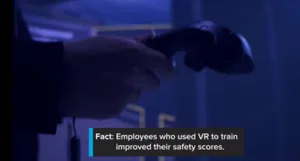Can virtual reality actually make a difference in the educational endeavor? That’s a question I asked in my previous two articles, “Flying High with Educational VR” and “VR for PT: Towards Educational Advantage”. In those articles, I highlighted specific instances of using VR to great effect in industry education settings.

In each case study, I highlighted five areas of realized benefit from the use of VR:
- Learning Efficiency
- Cost Avoidance
- Accelerating Learning
- Teaching Efficiency
- Increasing Capacity
This morning, however, a timely video splashed across my screen just prior to a desired news feed. This video highlighted the use of VR (in an educational context) by Koch Industries for purposes of safety and performance training.
In researching VR at Koch, I ran across their stated goal of using VR to achieve “zero significant process incidents or serious injuries”. According to their website, the application of VR has produced training score improvements of 20% from pre-test to post-test. This line of thinking is fairly standard in scoring how effective we are with the use of VR in instruction. Typically, we think of evidentiary low-lying fruit: retention, engagement, and pre-post-test results. But is there a more meaningful and superior approach to providing a clearer sense of return on investment for VR? Why, in the educational endeavor, does the notion of return on investment so often render itself as murky and difficult to measure, at least at first blush? The five categories of benefit bulleted above, and not the low-lying fruit mentioned, remain more meaningful, a far superior approach to providing a clear sense of direct return on investment for VR in the education space.
In the previously mentioned articles, I provided contextual examples of the financial and structural benefits of employing VR; here I want to explain my reasoning as to each of the five ‘benefit’ categories and why they matter more than the “retention-engagement-post-test” troika.
Learning Efficiency. Learning efficiency simply means that students can reach a deep understanding of their learning goals in a shorter amount of time. This economy in learning really matters. When teachers and learners are more efficient, it frees up more time in the curriculum to cover or learn [more topics]—or to go deeper than the students were able to go before. As an example, consider the time-saving advantages of such a familiar educational technology as the word processor; or think about the omnipresent graphing calculators in schools, which enable students to complete ten times the number of transformations than are possible with pencil and graph paper in the same amount of time. That’s learning efficiency in a nutshell
Cost Avoidance. A close cousin of ROI, cost avoidance purports that costs can either be reduced or avoided. In my past career as a technology director, I have used this line of thinking to promote legacy projector and display replacement, highlighting such obvious factors as energy savings, maintenance cost reductions, and total cost of ownership.
Accelerating Learning. Curriculum acceleration is moving leaners ahead sooner; more advanced learning earlier. Imagine middle school students learning high school content; high school students taking advance placement courses for university credit; sophomore air force cadets acquiring flight skills before they are usually acquired, by senior cadets; and more advanced skillsets reached by junior employees. How does this all work? It’s no surprise. It’s the power of visualization in learning. Even the U.S. National Science Foundation National Institutes of Health note in their seminal report, calling for more visualization tool development: “Visualization plays a role in saving lives, accelerating discovery, and promoting education through improved understanding.” The growth dividend associated with the acceleration of curriculum is attractive in any setting, especially if it speeds up time of service or product delivery.
Teaching Efficiency. Teaching efficiency is all about accomplishing more in less time, from the instructor’s perspective. For example, if we can we teach welding/car repair more quickly through VR to vocational ed students, then we have more time to dedicate to improving their technical reading/writing skills; if we can teach component repair/manufacturing/safety more quickly through VR, then we don’t have to pull employees off the line, as disruptive as that can be, for as many hours/days as before.
Increasing Capacity. VR systems can also allow us to expand our capacity to do more or take on more customers. We might be limited in the number of service bays, but VR can provide virtual bays, extending our capacity; we may be constrained by shrinking numbers of qualified instructors, but VR training systems can enable our limited instructors to touch more students, while we rush hiring to increase our instructor ranks; and we can increase the number of trainees we can serve, when a rush of retirements or business expansion demands it.
Although scoring the benefits of virtual reality by means of retention, engagement or post-test performance studies may prove a fool’s errand, the above metrics are worth their weight in gold.– Len Scrogan

